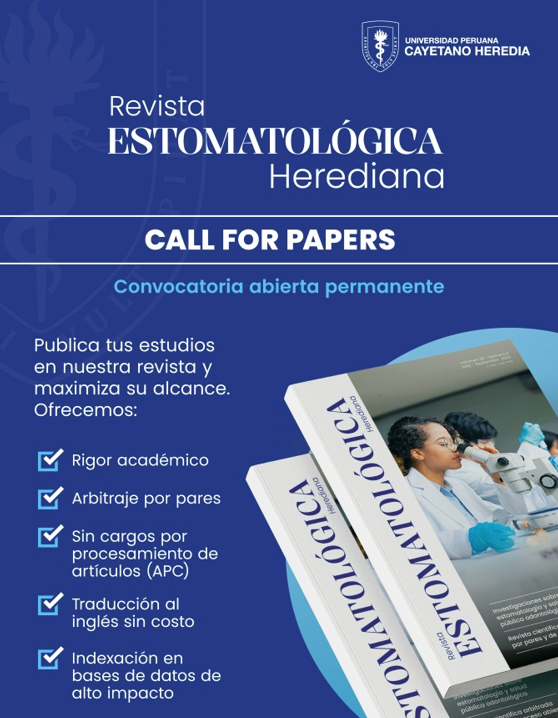Lo que debemos saber sobre dentífricos blanqueadores.
DOI:
https://doi.org/10.20453/reh.v32i4.4381Palabras clave:
Dentífricos, blanqueamiento de dientes, blanqueadores dentalesResumen
El color de los dientes puede alterarse por sustancias pigmentantes o cromógenas, por retención en el biofilm dental, placa bacteriana o por la alteración química de la superficie dentaria. Dentro de los productos disponibles para retirar estas pigmentaciones, con el objetivo de mantener el color de los dientes naturales, se encuentran los dentífricos blanqueadores, los cuales poseen la característica de ser de libre acceso y pueden ser adquiridos sin receta médica. Estos dentífricos emplean mecanismos mecánicos, químicos o físicos; además no provocan mayor abrasión del esmalte cuando se comparan con los dentífricos convencionales. Este artículo de revisión tuvo como objetivo evaluar la evidencia sobre la eficacia de los dentífricos blanqueadores sobre el color de los dientes además de verificar los potenciales riesgos por su uso frecuente.
Descargas
Citas
Naidu AS, Bennani V, Brunton JMAP, Brunton P. Over-the-Counter Tooth Whitening Agents: A Review of Literature. Braz Dent J. 2020;31(3):221-235.
Devila A, Lasta R, Zanella L, Agnol MD, Rodrigues-Junior SA. Efficacy and Adverse Effects of Whitening Dentifrices Compared With Other Products: A Systematic Review and Meta-analysis. Oper Dent. 2020;45(2):E77-E90.
Soeteman GD, Valkenburg C, Van der Weijden GA, Van Loveren C, Bakker E, Slot DE. Whitening dentifrice and tooth surface discoloration-a systematic review and meta-analysis. Int J Dent Hyg. 2018;16(1):24-35. DOI: 10.1111/idh.12289
De Boer P, Duinkerke ASH, Arends J. Influence of tooth paste particle size and tooth brush stiffness on dentine abrasión in vitro. Caries Research 1985;19:232–239.
Santana J, Noronha C, Tonani R, Geng R, de Carvalho F. Over-the-counter bleaching agents can help with tooth whitening maintenance. J Esthet Restor Dent. 2022;34(2):328-334. DOI: 10.1111/jerd.12617
Baig A, He T, Buisson J, Sagel L, Suszcynsky-Meister E, White DJ. Extrinsic whitening effects of sodium hexametaphosphate—a review including a dentifrice with stabilized stannous fluoride. Compend Contin Educ Dent. 2005;26(Suppl.):47–53.
Harte DB, Manly RS. Four variables affecting magnitude of dentifrice abrasiveness. J Dent Res 1976; 55:322–7.
Casado BGS, Moraes SLD, Souza GFM, et al. Efficacy of Dental Bleaching with Whitening Dentifrices: A Systematic Review. Int J Dent. 2018;2018:7868531.
Ganss C, Marten J, Hara AT, Schlueter N. Toothpastes and enamel erosion/abrasion - Impact of active ingredients and the particulate fraction. J Dent. 2016;54:62-67.
Ablal MA, Adeyemi AA, Jarad FD. The whitening effect of chlorine dioxide--an in vitro study. J Dent. 2013;41 (Suppl 5):76-81.
Vaz VTP, Jubilato DP, Oliveira MRM, et al. Whitening toothpaste containing activated charcoal, blue covarine, hydrogen peroxide or microbeads: which one is the most effective? J Appl Oral Sci. 2019; 27:e20180051.
Meireles SS, de Sousa JP, Lins RBE, Sampaio FC. Efficacy of whitening toothpaste containing blue covarine: A double-blind controlled randomized clinical trial. J Esthet Restor Dent. 2021;33(2):341-50
Greenwall-Cohen J, Francois P, Silikas N, Greenwall L, Le Goff S, Attal JP. The safety and efficacy of ‘over the counter’ bleaching products in the UK. Br Dent J. 2019;226(4):271-276.
Pintado-Palomino K, Vasconcelos CV, Silva RJ, et al. Effect of whitening dentifrices: a double-blind randomized controlled trial. Braz Oral Res. 2016;30(1):e82. DOI: 10.1590/1807-3107BOR-2016.vol30.0082 15. Horn BA, Bittencourt BF, Gomes OM, Farhat PA. Clinical evaluation of the whitening effect of over-the-counter dentifrices on vital teeth. Braz Dent J. 2014;25(3):203-6.
Dietschi D, Benbachir N, Krejci I. In vitro colorimetric evaluation of the efficacy of home bleaching and over-the-counter bleaching products. Quintessence Int. 2010;41(6):505-16.
Simões ACCD, Dionizio A, Câmara JVF, et al. Do commercial whitening dentifrices increase enamel erosive tooth wear? J Appl Oral Sci. 2020;28:e20190163.
Kwon SR, Wertz PW. Review of the Mechanism of Tooth Whitening. J Esthet Restor Dent. 2015;27(5):240-57.
Hara AT, Turssi CP. Baking soda as an abrasive in toothpastes: Mechanism of action and safety and effectiveness considerations. J Am Dent Assoc. 2017;148(11S):S27-S33
Ahrari F, Hasanzadeh N, Rajabi O, Forouzannejad Z. Effectiveness of sodium bicarbonate combined with hydrogen peroxide and CPP-ACPF in whitening and microhardness of enamel. J Clin Exp Dent. 2017;9(3):e344-e350.
Descargas
Publicado
Cómo citar
Número
Sección
Licencia
Los autores conservan los derechos de autor y ceden a la revista el derecho de primera publicación, con el trabajo registrado con la Licencia de Creative Commons, que permite a terceros utilizar lo publicado siempre que mencionen la autoría del trabajo, y a la primera publicación en esta revista.























